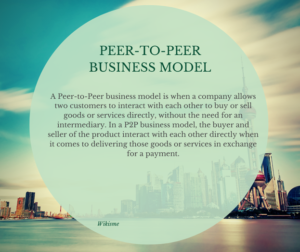A Peer-to-Peer business model is when a company allows two customers to interact with each other to buy or sell goods or services directly, without the need for an intermediary. In a P2P business model, the buyer and seller of the product interact with each other directly when it comes to delivering those goods or services in exchange for a payment.
In the P2P business model, the seller is usually an individual or a contractor who owns their tools and the finished product. It is the opposite of other business models, like the B2B business model, which comes from the interaction between two businesses. Companies using the P2P model get involved in this process by providing a platform for businesses to use.
For example, freelancing platforms allow for better P2P dealings, making them an intermediary in the process. In those cases, there is only one intermediary that gets involved. These companies make dealing with other customers, usually individuals, easier.
The P2P business model existed for a long as agencies allowed contractors to connect with individual buyers. However, with technological advancements, particularly due to the internet, these businesses have become more common worldwide. In fact, most P2P businesses are among the most successful names that don’t follow the traditional B2B or B2C business models.

How does the Peer-to-Peer (P2P) business model work?
The Peer-to-Peer business model is straightforward. Usually, a company offers a platform on which customers can sign up. Once the customer signs up, they can offer their services or, in some other cases, look for jobs that suit their skills. In this process, they have to look for other customers or consumers who are willing to buy their products or services and pay them.
Once they find a consumer on the platform, they can deal with them directly. They also decide on what each party should do to fulfill their part. Usually, the customer will offer a product or service while the consumer pays the fee or price in exchange. In between, the company that relies on the P2P business model provides a platform for their interaction.
A company that uses a Peer-to-Peer business model can earn money in various ways. Usually, the seller in the transaction has to pay a specific amount to offer their services on the platform provided by the company. The seller can recover the amount from the price they charge their consumer. However, sometimes, the buyer may also have to pay to use the platform.
Usually, the company in this business model is also responsible for marketing and advertising its platform. Through that, they also promote the customers that offer their products or services on their platform. The customer only needs to use the platform and not worry about promotions. However, they may still choose to promote their personal services if the platform allows it.
What are the advantages and disadvantages of the Peer-to-Peer (P2P) business model?
The Peer-to-Peer business model is advantageous for all parties involved. However, it may come with its disadvantages as well. Some of the advantages and disadvantages of using the P2P business model are below.
Advantages
The most crucial advantage of the Peer-to-Peer business model is its directness. Using a platform, customers and consumers can interact and buy or sell their goods or services. The company that offers the platform can earn from their interactions without having to do much.
Similarly, the P2P business model is also becoming more popular among users of the internet. Many online platforms allow P2P transactions to users online. Due to its popularity, it provides more exposure to its users, due to which they can earn more. Since most companies using this model earn from users’ interactions, the more their customers make, the more the companies make.
Disadvantages
The disadvantage of this business model that often gets discussed is the high competition with which it comes. Peer-to-Peer businesses are easy to initiate and build, making it difficult for the established names in the industry to settle down. While more competition is better for users of these platforms, for the companies, it is not.
Examples
Freelancing platforms, such as Fiverr, Freelancer, Upwork, etc., are examples of the Peer-to-Peer business model. These companies offer customers a platform to provide their services, which consumers can choose and buy. Similarly, companies such as Uber and Lyft allow for peer-to-peer transactions, which indicates they also use this business model.
Conclusion
The Peer-to-Peer business model allows companies to offer a platform where users can interact with each other. Through their interactions, companies can earn more money. A straightforward business model is often considered the opposite of traditional models such as the B2B model.